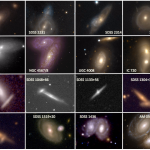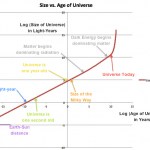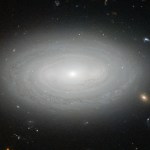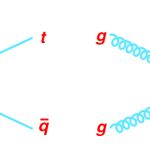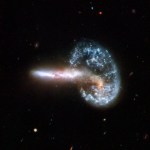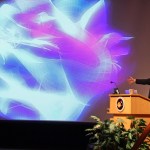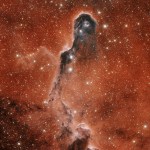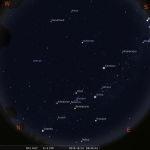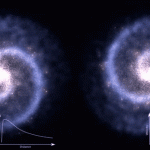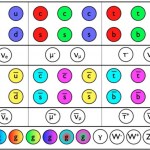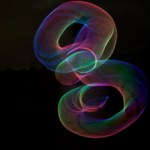
"I know there is strength in the differences between us. I know there is comfort where we overlap." -Ani DiFranco
The observable Universe is a big, big place. Some 46 billion light years in all directions, with hundreds of billions of galaxies inside, it's no wonder that we see stars and galaxies in all directions we've ever looked. What's even more of a surprise, though, is that sometimes galaxies that aren't at all close together look like they are, and overlap.
Image credit: Sloan Digital Sky Survey / William Keel, of NGC 3861.
These optical illusions are caused by the uncommon…
“This whole Santa Claus thing just doesn't make sense. Why all the secrecy? Why all the mystery?
If the guy exists why doesn't he ever show himself and prove it?
And if he doesn't exist what's the meaning of all this?” -Calvin, via Bill Watterson
This is our last comments of the week for 2015, and Starts With A Bang can't wait for the new year! All the great things we've worked so hard for this year promise to bring about an even better one in 2016. But that said, there's still more science for this year! This past week saw the following:
When a photon gets redshifted, where…
"They say it all started out with a big bang. But, what I wonder is, was it a big bang or did it just seem big because there wasn't anything else drown it out at the time?" -Karl Pilkington
Looking out at the distant stars, galaxies and radiation in the Universe today, we've been able to determine not only what it's made out of, but how long it's been since the Big Bang: 13.8 billion years. Put all that information together, and you can also figure out how large the observable part of that Universe is today. From our point of view, it appears to extend for 46.1 billion light years in all…
"If the expansion of the space of the universe is uniform in all directions, an observer located in anyone of the galaxies will see all other galaxies running away from him at velocities proportional to their distances from the observer." -George Gamow
When Einstein put forth his space-and-time changing theory of General Relativity, one of the consequences he didn't anticipate -- and, in fact, resisted -- was the fact that a static Universe would be unstable, and that the Universe must be either expanding or contracting. While the theoretical work of many, such as de Sitter, Friedmann and…
"It's like trying to describe what you feel when you're standing on the rim of the Grand Canyon or remembering your first love or the birth of your child. You have to be there to really know what it's like." -Harrison Schmitt
They say that one of the most exciting phrases to hear in science is not "eureka!" but "that's funny," and the Apollo 17 astronauts, just over 43 years ago, certainly got such a moment when they discovered orange soil just beneath the grey regiolith.
Image credit: NASA / Apollo 17.
What turned out to be volcanic glass with tin inclusions had another surprise: olivine…
"As of now, string theorists have no explanation of why there are three large dimensions as well as time, and the other dimensions are microscopic. Proposals about that have been all over the map." -Edward Witten
Earlier this month, a conference was held devoted to the question of whether untestable scientific ideas like string theory and the multiverse are actually science or not. While many opinions were stated and no one changed their mind, the answer is apparent: unless you're willing to change the definition of science to include 'this thing that isn't science,' then no, string theory is…
"I often feel a discomfort, a kind of embarrassment, when I explain elementary-particle physics to laypeople. It all seems so arbitrary - the ridiculous collection of fundamental particles, the lack of pattern to their masses." -Leonard Susskind
When it comes to physics, there are a tremendous number of unsolved problems that seem to mandate the existence of a new particle. These include the dark matter problem, the matter-antimatter asymmetry problem, the massive neutrino problem and the strong-CP problem. Moreover, these particles required cannot be part of the Standard Model: they must lie…
"For me, the study of these laws is inseparable from a love of Nature in all its manifestations." - Murray Gell-Mann
When you take a glimpse into the deep Universe, beyond the gas, dust, stars and planets of our own galaxy, you enter the realm of the galaxies. In general, they come in two types: the spirals, with neat, orderly arms, and the ellipticals, with a symmetric, bulging shape. But for everything that exists in the Universe a particular way in general, there are exceptions.
Arp 273, with both galaxies clearly affected by the interaction. Image credit: NASA, ESA and the Hubble…
"Our family was too strange and weird for even Santa Claus to come visit... Santa, who was jolly - but, let's face it, he was also very judgmental." -Julia Sweeney
Everyone loves to point out the holes in the Santa Claus theory. After all, how could one person with a sled, powered by eight flying reindeer, deliver presents in one night to hundreds of millions of households all over the world? And yet, every Christmas morning, children wake up to find they did, in fact, get a visit from Santa.
Image credit: Wikimedia Commons user Glogger, of the Santa Claus parade in Toronto, 2007.…
"As far as extra dimensions are concerned, very tiny extra dimensions wouldn't be perceived in everyday life, just as atoms aren't: we see many atoms together but we don't see atoms individually." -Ed Witten
As we approach the end of the year, Starts With A Bang looks ahead to what's new and upcoming, rather than back on the year that was. This past week, here's what we tackled:
Why aren't spiral galaxies more wound up? (for Ask Ethan),
Coloring The Universe vs. The Hubble Cosmos (for Gift This, Not That),
How young stars appear in old clusters (for Mostly Mute…
"...in every kind of chemical change no loss of matter occurs [...] in all the varied modes of physical change, no loss of energy takes place." -Sir Henry Enfield Roscoe
When it comes to the physical laws of the Universe, perhaps the most unbreakable of all seems to be the law of conservation of energy. In every mechanical, chemical, or even nuclear reaction, the total amount of energy, when all sources are considered, appear to be conserved.
Image credit: NASA / SDO.
Yet in General Relativity, no strict definition of energy exists. So when the Universe expands, the photons…
“I just think too many nice things have happened in string theory for it to be all wrong. Humans do not understand it very well, but I just don’t believe there is a big cosmic conspiracy that created this incredible thing that has nothing to do with the real world.” -Edward Witten
String theory is often touted as the best option for physics beyond the Standard Model, and for unifying gravity with quantum theory. No one disputes the need for a quantum theory of gravity, as general relativity is woefully insufficient for describing gravitational fields at extremely small distances.
Image…
“For last year's words belong to last year's language And next year's words await another voice.” -T.S. Eliot
It's the end of the year, and so you know what that means: time for lazy recaps of "the year that was" everywhere you look. Why settle for last year's news, though, when you can start making predictions about what next year will hold?
Image credit: Caltech/MIT/LIGO Laboratory.
I make 10 bold predictions for what 2016 will hold, including:
the first detection of a gravitational wave,
a new record for the smallest exoplanet atmosphere with water,
that the "super-Earth"…
“I wasn’t destined to be an astronaut. I had to turn myself into one.” -Chris Hadfield
Many of us dream of becoming astronauts as a child, but give up on that dream for a number of reasons — the seemingly impossible odds, the demands of daily life, the rigors of preparation — and never even apply. But for a great many, that dream remains alive; the last time NASA had open applications, over 6,000 people threw their hat in the ring, with eight selected.
Image credit: NASA; Photographer: Robert Markowitz. NASA Administrator Charlie Bolden, at lectern in the middle of the frame, speaks at a…
"Youth is the gift of nature, but age is a work of art." -Stanislaw Jerzy Lec
When stars are born, it normally happens in groups of thousands or more, all at once. They range from just 8% the mass of our Sun, which are dim, red, and long-lived, to dozens or even hundreds of times as massive: the brightest, bluest and shortest-lived stars of all. Because they burn through their fuel the fastest, these most massive stars cease to exist the most quickly.
Image credit: Christopher Tout, Nature 478, 331–332 (2011), via http://www.nature.com/nature/journal/v478/n7369/full/478331a.html.
Yet…
“The time will come when diligent research over long periods will bring to light things which now lie hidden. A single lifetime, even though entirely devoted to the sky, would not be enough for the investigation of so vast a subject... And so this knowledge will be unfolded only through long successive ages. There will come a time when our descendants will be amazed that we did not know things that are so plain to them... Many discoveries are reserved for ages still to come, when memory of us will have been effaced.” -Seneca
If you love what's out there in the Universe -- the science, the…
“"There is a fundamental difference between religion, which is based on authority, [and] science, which is based on observation and reason. Science will win, because it works."” -Stephen Hawking
Every week on Starts With A Bang brings with it a new set of considerations about the Universe we all inhabit. It was awfully busy here, with two guest contributions, including:
How do black holes really evaporate? (for Ask Ethan),
Your guide to the best meteor shower of the year: the Geminids,
Amazing final images of stars right before they die (for Mostly Mute Monday),…
"The farther we peer into space, the more we realize that the nature of the universe cannot be understood fully by inspecting spiral galaxies or watching distant supernovas. It lies deeper." -Robert Lanza
When you take a look at a spiral galaxy in the night sky, it seems obvious that the stars on the inner parts of the galaxy are going to orbit in less time than the stars in the outer part. This turns out to be true, something we've figured out even though the timescales for galaxies to complete a full revolution are far longer than we've ever been able to observe.
Image credit: ESO, taken…
“I just think too many nice things have happened in string theory for it to be all wrong. Humans do not understand it very well, but I just don’t believe there is a big cosmic conspiracy that created this incredible thing that has nothing to do with the real world.” -Ed Witten
If you calculate the forces between two fundamental particles separated by subatomic distances, you find that the strong, electromagnetic or weak nuclear force could all be the strongest, dependent on the particulars of your setup. But throw gravity in there, and it turns out to be weaker by some 40 orders of magnitude…
“Did you ever read my words, or did you merely finger through them for quotations which you thought might valuably support an already conceived idea concerning some old and distorted connection between us?” -Audre Lorde
One of the most damning, albeit accurate, condemnations of String Theory that has been leveled at it is that it's untestable, non-empirical, and offers no concrete predictions or methods of falsification. Yet some have attempted to address this failing not by coming up with concrete predictions or falsifiable tests, but by redefining what is meant by theory confirmation.…
